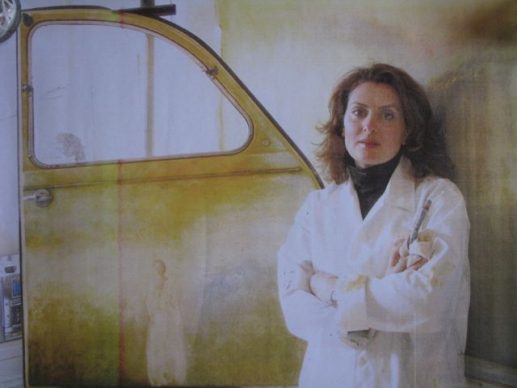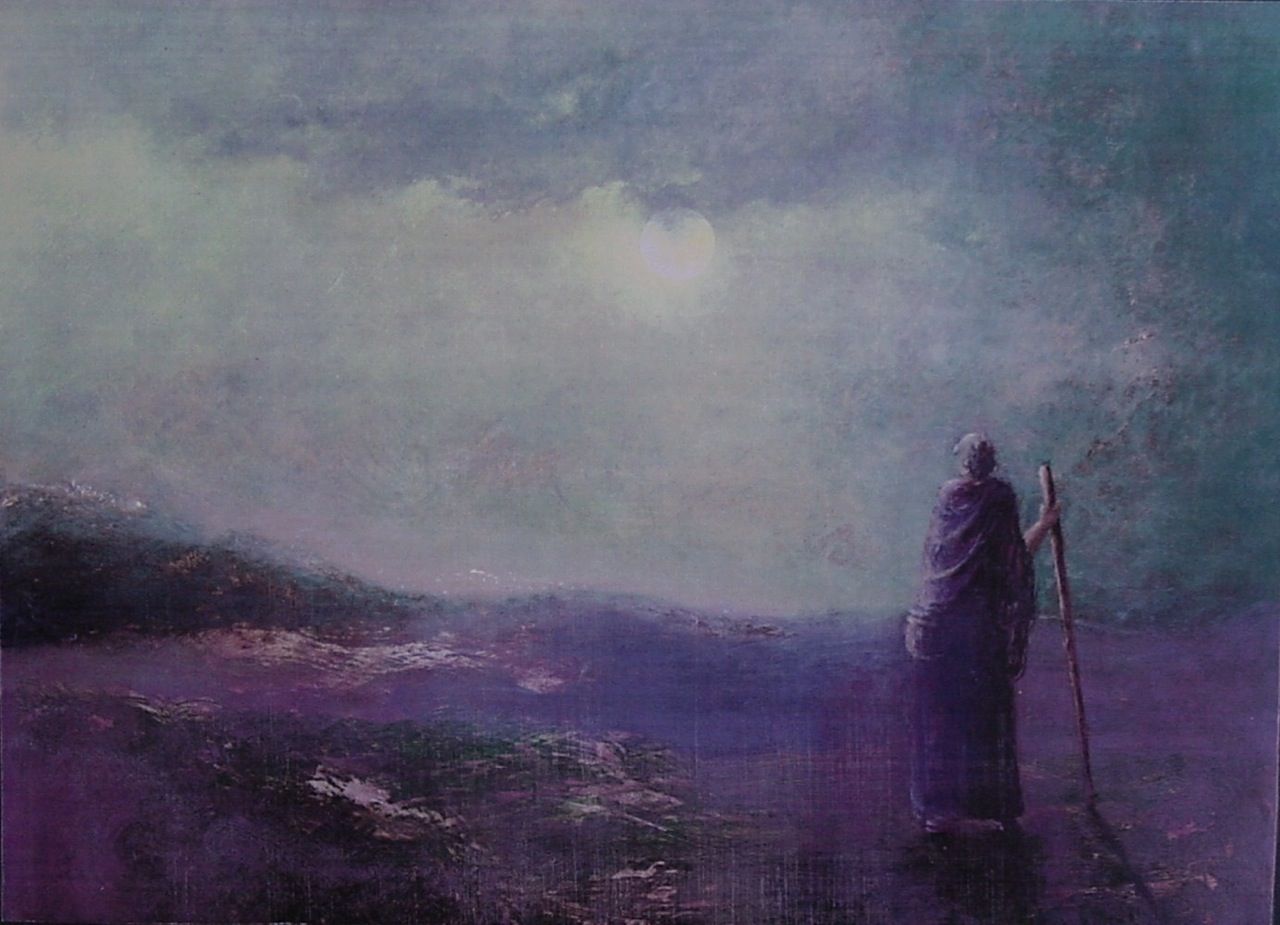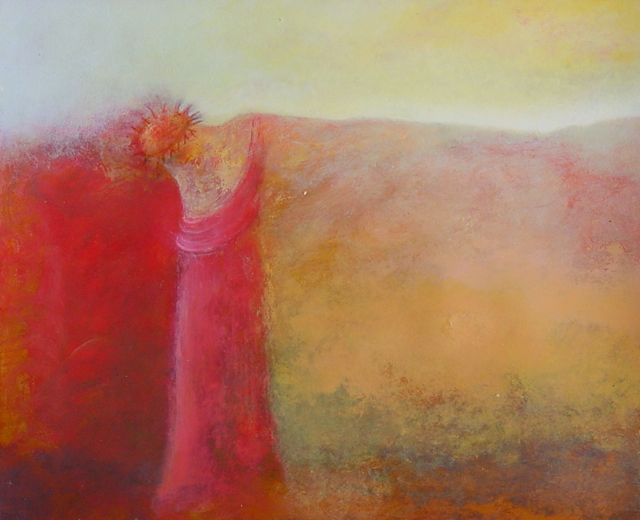Although born and raised in Lebanon, Joumana left Beirut for Paris to complete her studies as an artist. But it was when she joined the Church, through a friend in Lebanon, that she came into her own as an artist. Today, Joumana’s stunning paintings are infused with gospel symbolism and a measure of the Spirit that makes them undeniably moving. Lire cette interview en français
How were you raised?
After the war in Lebanon, and after my fine arts studies in Beirut, I came to Paris to pursue my studies. I’m from a family of artists, so my first drawing was on a wooden cheese box–I was about five when I drew it–and since my father was an artist I spent hours in his studio, sometimes “borrowing” a few tools for my own art. I think it’s something I was born with because my two sisters and two brothers and I all became artists.
Does having two cultures, French and Lebanese, influence your creative process?
In Lebanon we have a very French culture: there’s always been a strong connection between France and Lebanon; we call France our “protective mother.” So moving to France didn’t change too much for me except that our culture is a bit more Mediterranean in Lebanon. We’re more like the Italians or the Greeks: we like to talk a lot, whereas the French are generally wonderful people with big hearts, but they don’t express it enough. So I struggled because as an artist you need human contact, and I had always had a warm atmosphere around me. Ever since childhood I was in an open home where people came in and out all day long: there were painters, sculptors, writers, cinematographers; it was an artistic world and that’s how I was raised. It was a very rich world–my parents hosted events and one artist would start singing, another would start dancing… it was a wonderful time of my life that I miss now.
When my sister Gina and I were younger we experimented a lot and created fancy jewelry, and it was only later when I first took fine arts classes that I decided to become a painter. And at some point, because I had a famous father with a very imposing personality, I had to stop and do something else, despite my parents’ constant encouragement to keep painting, because I wanted to exist for myself. That’s actually the reason I changed my name, because every time someone met me they would say, “Oh, you’re so-and-so’s daughter” and they saw him and not me. I noticed I wasn’t the only one, either; I met plenty of people who had a famous mother or father and who needed to trace their own route. Everyone in my family carries the Nahlé name, whereas I decided to take on my husband’s name. So I spent four years at the BJO (School of Jewelry and Goldsmith’s Craft) in Paris, which allowed me to mix painting with other perspectives until the point that I learned about the Church. The day I discovered the Church is the day my art completely changed.
How so?
Before, my work was very cubic, cerebral, and very philosophically symbolic; ever since I was five I had always drawn with china ink, black and white, and that’s it. After my baptism, the first drawing I made almost drew itself. It was just a tiny little sketch of the spirit world. There were people living in darkness in a prison somewhere, and on a high mountain you could see Joseph Smith and a few disciples. I never really attempted to draw Joseph Smith’s face, but for me that’s who it was – that’s how it came out and I felt it was him.
When I paint, I don’t know what I’m painting. I do figurative abstract, which means that you can see a personage but there is a great deal of abstraction; I work mostly on the message. For me, a painting that doesn’t have a message, that doesn’t touch people, just doesn’t work. So I just let myself go on a blank canvas; I paint but don’t know exactly what I’m painting at first. It’s at the end, after having worked for a while, that I discover what it’s supposed to be.
For me it’s a very spiritual process, it works with the Spirit. I pray that the Spirit will work with me so that when people look at a painting, it’s not just an aesthetic work; it’s first and foremost something that can speak to the spirit. And I was very happy when during several of my expositions people came to me to tell me how they had felt peace. So all of a sudden my painting changed from something that was tough with very harsh and very structured lines to something that had softness, unified colors, and very spiritual themes. Personally I feel like there is a lot of decadence in the art world. There’s an artistic lobby that is driven by business. We’re wrapped up in this lie that anything that is spiritual or has to do with God or the human being is out of style; it’s boring and it doesn’t “flash”–it’s not extraordinary. But I can’t just do something to be famous around the world; I need to do something that I feel.

“Faithfulness”
Tell me more about your spiritual experiences with art.
Well, for example I had a special experience with the painting called “Consolation.” When I first started painting I created a large space and eventually a personage appeared. When I saw this I understood it was supposed to be Christ. And with this space I thought, “Jesus is alone, so He’s in the desert,” and little by little I saw more. Halfway through, I understood it was Christ alone and I decided it would be the forty days in the desert. But I wanted to add an angel and I couldn’t remember anything in the scriptures about it, yet I really strongly felt that I should add an angel to comfort Him. So I added a small bird on the angel’s hand and the other hand was on Christ’s shoulder to comfort Him. And I thought that maybe I shouldn’t do something like that, make up characters. I finally went to the scriptures and I was very surprised because I had forgotten that detail of an angel coming to comfort Him (Matthew 4:11). It was a wonderful feeling.
In another painting, that same personage reappeared, but this time it was Christ’s hand with a personage that represents all of us, and the hand of our Savior lifts the person up. It’s as if to say that whenever we feel heavy, the Savior is always by our side to lift us up.
How did you join the Church?
Ever since I was young, I’ve always prayed. At the time I didn’t know “Heavenly Father,” so I simply prayed to God. We were raised in Catholic school and the nuns were very strict, but in my head I had this prayer I had made up with God. On the other hand, I was never very religious. My brother who is two years younger than me discovered the Church in Lebanon, during the eighties. He met a sister who was a member and was desperate to know more, but at the time there wasn’t much knowledge because the Church hadn’t yet been restored in Lebanon after the war in the seventies–there was nothing; it was more or less to each his own, with only a small group of members baptized in Europe waiting, hoping for a change. He ended up flying to France, where I was living at the time, and he went straight to the US embassy to ask where he could find the Church of Jesus Christ of Latter-day Saints! He was baptized and quickly left on a mission to Minnesota, and he regularly wrote me. He would always ask me to read the Book of Mormon, but I really wasn’t ready.
Then one night, I had a dream and I saw Christ in my dream: I saw myself in a stone tomb, like the ones in the Middle Ages, but it was open and I was sleeping and I held a small pouch in my hands–which meant that I wouldn’t be able to take many things with me after this life. At the time I was really living “in the world”; I partied a lot; I had a very pleasant, easy life … and there I was, with nothing but a tiny pouch. There were also two people in another tomb (I later understood that they were missionaries); they were young and they were looking at me but I was pretending to sleep. Then an extraordinarily beautiful personage came and took me by the hand to lift me out of the tomb. The missionaries were looking at me with big, surprised eyes. He took me on a mountaintop and there was a wooden table and bench. I sat next to Him and He began to speak to me. He asked me what I wanted to drink and suddenly He was all in white with white hair. I answered, “Water” and He said, “It is well.” Then He asked me a question that really frustrated me: “What in your life has the most value?” I told Him I didn’t know. He raised three fingers and said, “There are three things…” and as He was about to tell me what they were the phone rang. I was so frustrated! I closed my eyes and tried so hard to get the dream back.
Six months later, I decided to return to Lebanon, and my brother’s friend who had introduced the gospel to him told me all about the Church. I think it’s at that point that I gained a testimony, before even reading the Book of Mormon. My whole life, I had been trying to know God in my prayers but I didn’t know how to know Him.
How does being a woman influence your work? What difference does it make?
I think that we have a palette of intuitions and colors that mix together, and that’s important. As women we are sensitive, we can feel certain things. Personally, I am very attached to the human condition: I think often about women and men who are suffering; I think about children; I think about the family unit. And I try to put a measure of the Spirit into my paintings so that people can feel that Spirit when they see something–the Spirit that gives peace to your heart. It doesn’t come from the painting itself; it comes from the Spirit that was put into the painting and that Spirit doesn’t come from me. I love serving Heavenly Father and I know that, as I was told in a blessing one day when I was ill, painting is part of my mission on earth. It’s a tool that I can use to touch people’s hearts.

Does painting bring you closer to God?
Yes. When I paint I try to work very closely with the Lord. It’s not easy, though, because artists that paint models or still-lifes can rely on what they see, but when you’re trying to bring it all out from inside of yourself, with nothing else to rely on, it requires a great deal of energy. The joy comes later, but it’s an enormous challenge, and I have had times where I just couldn’t do something and it suddenly came all by itself. And I would say to myself, “This isn’t possible–only the hand of God could have accomplished this.” I felt completely incapable; I needed a model for certain details, and then it came in such a natural way that I understood how God helps each of us, all of His daughters. He loves us no matter our profession, our personality, or our situation. He loves everyone and He watches over us.
At A Glance
Name: Joumana Borderie
Age: 48
Location: Paris - La Défense
Marital Status: Married
Children: 9-year-old boy
Occupation: Painter/Creator
Schools Attended: École de Beaux Arts – Beirut, Grande École B.J .O – Paris
Languages Spoken at Home: French
Favorite Hymn: “If You Could Hie To Kolob”




